HOW TO DESIGN A HUMMINGBIRD GARDEN
Hummingbirds are fun to have around and the more you know about them, the more impressive they are. As these tiny birds are zooming around your garden, their hearts are beating 1000 times a minute and their wings are beating 50 times per second!
Hummingbirds are unique to the Americas, and luckily for us, there are about 20 different species that live in the U.S. for at least part of the year. In most cases they are summer residents who come north to next and raise their young. Gardeners can play an important role in assuring that these visiting hummingbirds stay as healthy and happy as possible.
If you have a flower garden you are already well on your way to having a hummingbird garden. But to make your yard and garden even more of a haven for hummingbirds, there are some easy things you can do to make them feel welcome.
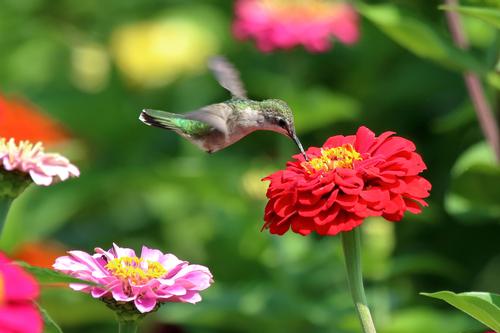
Flowers for Hummingbirds
Because of their fast metabolism, hummingbirds need to eat every 10 to 15 minutes. This can require visiting as many as 2000 flowers in a day, and at certain times of the year, finding that many flowers can be difficult. So the single most important thing you can do to help hummingbirds (as well as bees and other pollinators) is to grow plants that flower at different times during the season. Strive to always have something in bloom — from spring bulbs to fall asters. Flowering vines, shrubs and trees will also help to fill out the menu.
Most hummingbird species have long, thin bills that allow them to reach deep into blossoms where the nectar is stored. Then, with their bill slightly open, they use their forked tongue to quickly lap up the nectar inside. It’s sort of like how a dog or cat drinks water, only much faster. A hummingbird’s tongue protracts and retract 13 times per second!
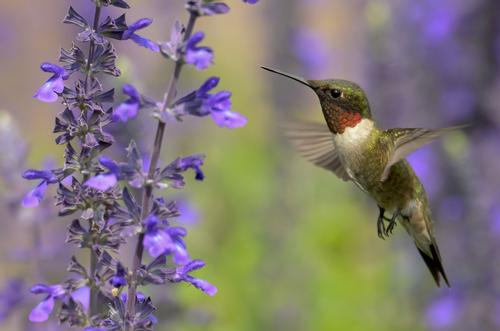
Hummingbirds have a poor sense of smell, so they are not attracted by fragrance. But their vision is better than ours, and includes being able to see the ultraviolet spectrum. They find red flowers irresistible, but pink, orange and purple are also appealing. In fact, you can be pretty confident that any brightly-colored flowers will catch their eye. For a full list of hummingbird favorites see: Flowers That Attract Hummingbirds.
Hanging baskets make it easy for hummingbirds to feed, especially when you fill them with flowers such as fuchsias, trailing petunias and geraniums. Since it’s relatively easy to hang these baskets close to your house, they’re also a good way to ensure some close-up viewing.
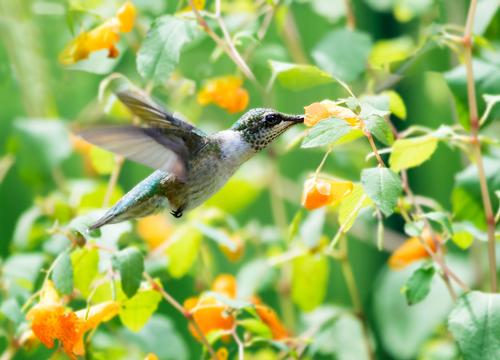
Insects
Many people are surprised to learn that hummingbirds eat insects as well as sip flower nectar. While nectar sustains their energy, insects give them the vitamins, minerals, amino acids, proteins, oils and fats they need to survive.
The insects hummingbirds eat depends on what’s available. Typically they consume beetles and bugs, flies, gnats, mosquitoes, aphids and leafhoppers. Spiders and daddy long legs are special favorites.
To protect the heath of hummingbirds, it’s very important to avoid using pesticides that could contaminate flowers or insects. Filling your yard, garden and other landscaped areas with a diversity of different types of plants, including natives, is the best way to cultivate a healthy ecosystem with a rich food supply.

Perches
Hummingbirds are the only birds that can hover and fly backwards. Performing these tricky maneuvers at an average flying speed of 25 to 30 mph uses a tremendous amount of energy. For this reason, their bursts of flight are usually relatively short. Hummingbirds actually spend up to 80% of the day sitting on a perch. Some of that time they are sunning or preening. But most of the time they are watching for insects or on the lookout for other hummers that may try to intrude on their territory.
Different species of hummingbirds prefer different types of perches. Favorites include dead twigs on a tree, leaf stems, the top rail of a fence and even a clothesline. If hummingbirds are regular visitors to your yard, you probably already know about some of their preferred resting areas. Having found a good perch, the same individual may return to it many times a day.
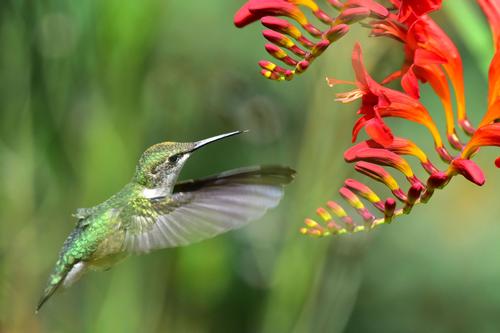
If you’d like to add more perching options, consider placing an arbor or trellis in your flower garden. The perch should be sturdy, at least 6 feet tall, and be surrounded by at least 10 feet of space that’s clear of leaves or branches. If you have hummingbird feeders, consider adding a perch nearby. It may become a popular place for resting or waiting in line between feedings.
Hummingbirds typically live about 5 years and will return to the same area where they hatched. Once identified, a favored perching place may be used for many years or even many generations.
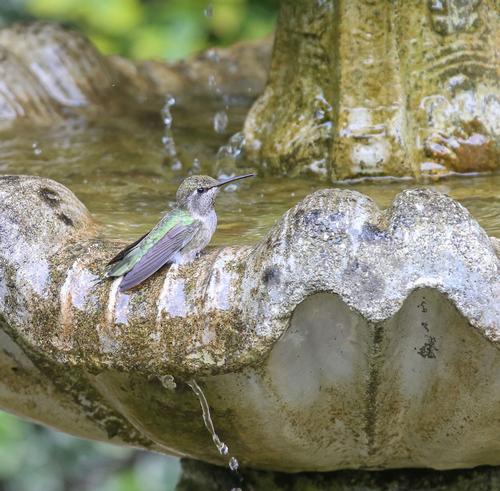
Water
In addition to food, hummingbirds also need water. Most of what they drink comes from flower nectar, but water is needed for bathing, which they must do frequently to keep their wings clean. Regular birdbaths are not suitable for hummingbirds. A sprinkler or a mister is safer and will be much more appealing. A water feature with a splashing fountain or dripper will also get their attention. Rough edges and lips or rims provide good places for perching.
Remember that water will also attract other wildlife that could pose a threat to hummingbirds. If possible, locate the mister, fountain or dripper on a raised surface that’s up off the ground. If there’s several feet of open space on all sides, there will be less risk of a surprise attack.
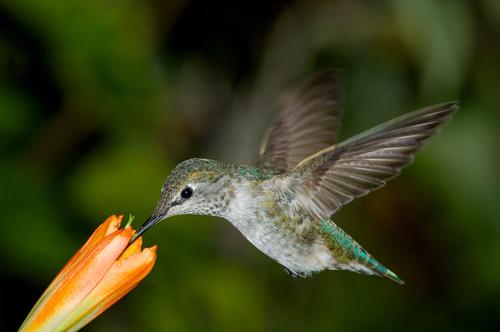
Ready to learn more? You may also be interested in reading: How to Design a Bee-Friendly Garden and Flowers That Attract Hummingbirds.
Hummingbirds at Home is the National Audubon Society’s citizen science program. Its objective is to learn more about hummingbirds and how to protect them. The information they offer includes a real-time seasonal migration map that lets you track the exact date when you can expect hummers to arrive in your area each spring.
